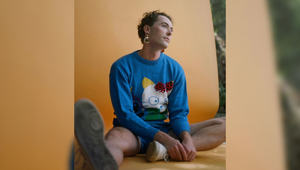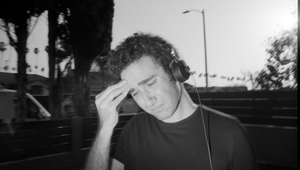
Behind the Work: Martin Krejci’s Gut-Wrenching Homecoming Style Gun Violence PSA

Homecoming videos of American troops have been a mainstay of the internet since the earliest days of widespread online video consumption. However, there is also a dangerous force waiting for them on their return, a force that threatens the daily lives of Americans more than anything abroad: gun violence.
According to gun safety organisation Newtown Action Alliance, more Americans to date have died from gun violence in the USA than in military combat. This insight is inspiration behind a new film for the organisation, '#NotComingHome', which was created by Serviceplan Hamburg, directed by Martin Krejci and co-produced by Iconoclast and Ruffian. It uses the homecoming video trend as inspiration but with a brutal twist.
LBB's Addison Capper chatted with Martin to find out the fascinating and at times gut-wrenching production process to make it.
LBB> How did this project initially come about? When you received the script, what were your initial thoughts?
Martin> I went to see my kids in LA after a commercial job I shot in Europe with Serviceplan. Nils Schwemer, the EP at Iconoclast Germany, called me and said that during one of the looong boring waits between the shots, the CD from Serviceplan had pitched him this project, which they wanted Gus van Sant to work on but he wasn’t avail. So Nils tried to sell me in since he knew I’d be in LA and it was a no budget PSA project. I called Robert Herman from Ruffian and because Robert and Nils knew each other from before, the idea of co-production made the pitch appealing to the agency I guess.
Having two children who are growing up in LA, visiting public middle schools, the message of this film was something I really wanted to help to get across in the most powerful way possible. The agency script offered a great opportunity to misdirect the audience and then punch them with the real meaning, which I thought was a fresh and effective way to get the message across.
LBB> Was the plan to always shape this as a faux homecoming video? With that in mind, how did it impact your approach to make this film?
Martin> In the agency script, it was more about the soldier returning to his wife in grief. I really liked the potential for the twist because the mislead makes the emotional charge of the second part more impactful, in my opinion. I liked that the idea of making the first part of the film really authentic and convincing as a ‘homecoming video’ wasn’t just some formal exercise. The surprising twist allowed me to go full on with the emotional performance in the second part which might have felt like an artificial tear jerk otherwise. It took a lot of trust from the agency, so I felt even more responsible because I really didn’t want them to regret that they let go of the need for control and let us film it this way.
LBB> From a production standpoint, how do you go about shooting something that is meant to be 'real'? For example, you've employed vertical phone cameras, door cams, etc. What other elements are there?
Martin> I wanted to protect the authenticity as much as possible so we created a special method for the production. We had eight hidden cameras linked together capturing everything all the time like in a reality show. Part of the plan was to let actors set them up as if they were the ones who put them in. In addition to that, we gave them phones and let them film the ‘homecoming’ part for real like we all know from those videos when the surprise is set up.
We ended up using only one of the hidden cameras in the final cut because the cast captured the scenes on their phones so perfectly that it felt like the right way to go. I wanted to use the vertical format for this part because that is how people usually film on phones and so it has that enhanced believability. All the mistakes with framing and imperfections were welcomed. We went really out of the box with it and that was the best fun about it. There was no crew on the set, the actors mostly didn’t know when we were shooting. With each take I only directed different cast members through a mic connected to their earpiece so others couldn’t hear it, which allowed me to provoke more natural reactions. (One of the mistakes left in the final film we didn’t intend – you can see the earpiece in mum’s ear when she collapses.)
LBB> What was the casting process like?
Martin> I wanted to cast real people as opposed to professional actors. The scale of this project didn’t allow for digging out the convincing authenticity in performance if there wasn’t help from reality, so I wanted to find a real life couple who have a child together so there was a real element in their life we could tune into. For the same reasons, I wanted to cast their real authentic friends and family. It was quite an unusual brief and we were really struggling with finding the right casting director who would be brave enough to go for this approach. Since the casting was such an important piece of the puzzle, the producers had to shift the whole production around three times across the US depending on who was willing to jump on the call with me to get the brief for the casting. At one point we were about to shoot the film in Atlanta, then I tried to get some film casting people I worked with in Buffalo but that was too short notice. In the end we were saved by Maya Adrabi from AHC in LA who found Annie and her husband for us.
LBB> And what kind of conversations were you having with the actors? How does shooting something that's meant to be 'real' impact your approach to working with actors?
Martin> I was always interested in the form of therapies like ‘Family Constellations’ and I thought that this project was perfectly suited for using that principle. The cast members brought their own props with a personal meaning to them, which we used on set. We had a whole day ‘pre-session’ on location when we dressed the location together. Then we sat down around the table and just talked about experiences of losing someone close to us. Thanks to the fact that most of the cast were real friends, it was more about gaining their trust in me and allowing them to open up as if it wasn’t a shoot – to embrace their own experiences and emotions.
In order to build the twist in a convincing way, we divided the shoot into two completely different parts in terms of motivations for the cast. In the first, we really wanted to set up the game as if the family knows the veteran is returning to his wife who isn’t aware of it and so they set up the surprise for her. Then after lunch we changed that to a completely different motivation – for the family to be there to support the mum who is in grief over a lost child and having her husband returning as an expected support. The final balance came from mixing those two performance approaches in the edit.
LBB> The mum's performance is intense and quite difficult to watch. How did you work with her on that?
Martin> Annie has the cutest five-year-old daughter ever who was effectively part of the cast. Annie allowed us to use the home videos with her, which we edited into a little sizzler reel. When she saw it all on the laptop in the scene, it helped her to dig in for convincing emotions as if her daughter was an actual victim of gun violence. It was one of the toughest shoots of my life because it felt like we were torturing Annie with each take. She managed to make the whole crew cry along with her about four times. If it wasn’t for such an important cause I wouldn’t be able to justify creating such a dark and heavy experience on the set for anyone, including myself.
LBB> What is the post production process like for a spot as stripped back as this?
Martin> I edited the film with my long-time collaborator Filip Malasek who has a special radar for cheesiness. The whole editorial process was about finding the right level of emotions because there is such a fine line which we didn’t want to cross - from authentic emotions to saccharine cheesy tear-jerker. I personally hate when my emotions are abused by some filmmakers and it usually prevents me from connecting with the film. I know that we all have this bar set up individually but with Filip’s involvement I hope that we have managed to find a good middle ground. Although it’s supposed to look like there was no touch from post, another long-time collaborator I’m proud to work with, Jean-Clement Soret at MPC, did two rounds of colour grading in order to make the look of the film believable, yet invisibly stylish.
LBB> What were the trickiest components and how did you overcome them?
Martin> When we had the presentation of the cast to the original client three days prior to the shoot, and we showed and explained to them the need for this approach, there was the longest 10-second silence from the client I have ever experienced. Then they told us that whilst they liked Annie’s authenticity, they wanted the family to be persons of colour. Our casting process had been intensive (it, of course, included people of colour) and finding Annie and her husband was a relief in terms of the feeling they brought to their performance - she was something of a Blue Bird. I believe that we all as humans can empathise with such a staggering loss no matter the ethnicity. I believed that we happened to find Annie and her husband as the best candidates based on that approach, and so I wanted to stick with them.
After that call I thought that the whole project was going to be cancelled. Instead, the agency called afterwards and said that they support the approach and that they were going to pitch the project to a different client instead. I have never experienced such bravery and support from the agency side like I did in this case. When I read the statement from Fred Guttenberg after the film release on CNN I felt like they did the right thing.










